VIENNA - I love cemeteries, because they’re alive with history. European gravesites especially fascinate me. A stroll through Paris’ Pere Lachaise Cemetery, where the likes of Chopin and Jim Morrison are buried, or Edinburgh’s 16th-century Greyfriars Kirkyard with its touching legend of Greyfriars’ Bobby (a faithful Skye terrier who spent 14 years guarding the gravesite of his master), or London’s Westminster Cathedral, where kings, queens, explorers and the giants of English literature lie in crypts under its cold marble floors is like taking a walk back through the ages.
But few cemeteries anywhere in the world can match Vienna’s Zentralfriedhof (Central Cemetery) for sheer size and especially importance in regards to who’s buried beneath its manicured lawns.
In this magical city, where classical music still rules, the legendary composers who wrote their great works centuries ago still draw a crowd — to their gravesites.
In an honorary section of Zentralfriedhof known as Ehrengräber, classical music greats like Beethoven, Brahms and the Strauss family, to name just a few, are gathered together off the main pathway leading to impressive Charles Borromeo Church, where many important burial services are held.
The composers are among an impressive list of people buried here — former Austrian presidents, lord mayors of Vienna, the city’s wealthiest citizens and the giants of European industry all end up in Zentralfriedhof — their graves marked by some of the most lavish headstones and monuments money can buy.
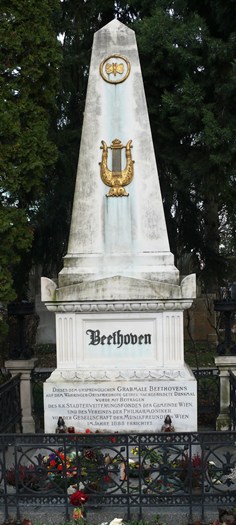
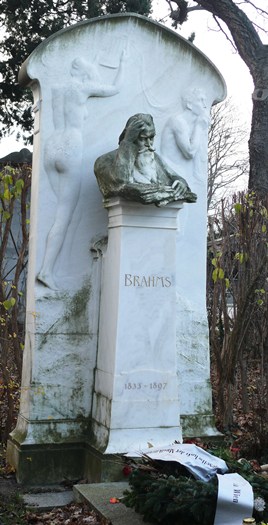
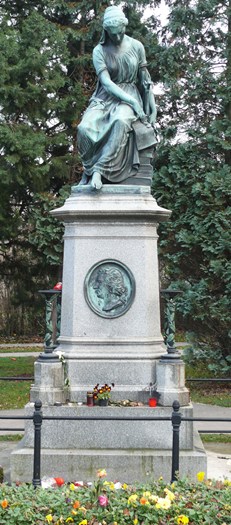
Above: Some of the world's greatest composers are buried at Vienna's lovely Zentralfriedhof cemetary.
But it’s the composers who draw the most attention at Zentralfriedhof, which was opened in 1863 after smaller city cemeteries filled up. Zentralfriedhof occupies 2.4 square kilometres of land — making it the second-largest cemetery in Europe — and is located in an area known as Simmering, a 20-minute tram ride from downtown Vienna.
Tourists make their way to Zentralfriedhof daily to pay homage to the composers, whose graves are decorated with candles and flowers left behind by the admiring throngs.
“The Japanese are the largest group of tourists who come to Zentralfriedhof to see the graves,” says Alexa Brauner, the delightful guide who leads me on a tour of the massive cemetery.
A monument erected to honour Wolfgang Amadeus Mozart, the enfant terrible of classical music and one of its greatest contributors, is the most popular with tourists. However, Mozart’s body actually lies in a much smaller cemetery — St. Marx — just outside Vienna’s historic Old City.
“Mozart died very poor (at age 35 from rheumatic fever) and his wife decided to have him buried in a mass grave, which wasn’t uncommon back then,” Alexa says.
Attempts to locate Mozart’s remains in the mass grave all failed, including one launched by his widow, Constanze, 17 years after his death. In 1855, a gravestone was erected in a spot presumed to be where Mozart rests but that monument was later moved to Zentralfriedhof so all the great composers could be honoured in one spot. In 1950, Viennese sculptor Florian Josephu-Drouot designed a new memorial for the mass grave in St. Marx, which stands alone in a small field were the poor lay.
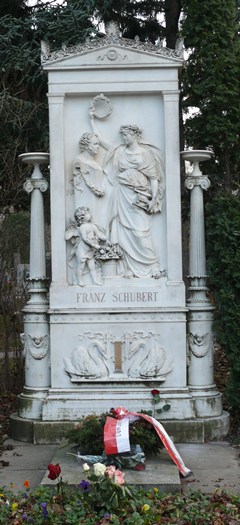
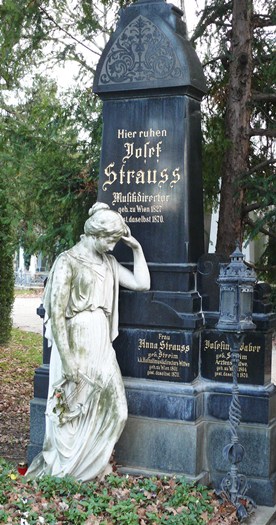
Above: Two of the most visited grave sites at Zentralfriedhof are Franz Schubert and Josef Strauss.
To the left of Mozart’s memorial at Zentralfriedhof rests the body of Ludiwg Van Beethoven, one of Austria’s greatest composer, whose remains were moved to the central cemetery in 1888 when the Ehrengräber section was completed.
Johannes Brahms, Antonio Salieri, Franz Schubert and the entire Strauss family, Johann, Eduard, Josef and their composer father, Johann Sr. are all buried within a few metres of each other.
On the way back to Vienna, we stop and tour St. Marx, an eerie place where ravens sit on decaying headstones and many of the walkways between the rows of graves have become impassable, overtaken by tangled brush.
Mozart’s admirers have not forgotten this place — candles and freshly picked flowers decorate the mass grave that’s now guarded by a single angel.
Vienna truly keeps its musical history alive at its beautiful cemeteries.
About the Author
Marc Atchison is a veteran journalist and a seasoned traveller with more than 20 years of travel writing experience. As the former Travel Editor of the Toronto Star, Canada's largest newspaper, and now Editor-in-Chief and Senior Writer for TraveLife magazine (Canada) and travelife.ca, Marc has been to over 100 countries in the world. Japan is one of his favorite destinations and he's been there on numerous occasions.